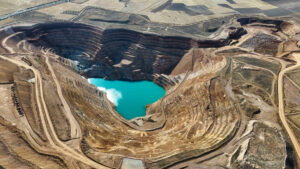Lefroy on track for maiden resource at Burns in 2023 as major gold-copper drill program begins

Pic: Fancy/Veer/Corbis via Getty Images
Since its discovery in 2021 the Burns gold-copper find near Kalgoorlie has drawn the intrigue of junior mining investors.
Lefroy Exploration’s (ASX:LEX) mineralized porphyries at Burns are unusual within the vaunted WA Goldfields, one of the world’s great factories of gold, nickel and lithium metals.
Shareholders are now just months away from seeing the potential of those early exciting hits realised, with a new reverse circulation program to complete more than 15,000m of drilling at Burns which will precede a maiden shallow resource estimate in the March quarter of 2023.
The intense drill drive is expected to take until January to complete, with first gold samples expected to be assayed by November, with copper, silver and cobalt results to follow.
Drilling will take place on a tight 40m by 40m pattern to a depth of around 200m from surface, covering a 700m by 500m footprint at Burns extending north and east into Lake Randall.
A land based program consisting of 50 angled RC holes is already under way, with lake based RC drilling on Lake Randall to start later this month.
Burnsing bright
Burns has, ahem, burned brightly since its discovery last year.
The initial find was made in a 22 hole RC program in an interval in hole LEFR260 containing 38m at 7.63g/t and 0.56% copper from 134m.
Located 70km southeast of Kal, it is a new and unique style of intrusion-related gold, copper, molybdenum and silver mineral system hosted by Archean age diorite-porphyry intrusives and high-magnesium basalt.
The limit of the mineralisation is yet to be found, with modelling highlighting a large, northwest trending and southerly plunging mineralised shell with a higher grade northerly trending gold-copper component tested in recent diamond holes.
This interpretation was supported by aircore intersections at Lake Randall, 240m north of Lefroy’s discovery hole with an intersection of 24m at 2.86g/t from 16m in LEFA1089.
Assay results released yesterday from a 1245m deep diamond hole at Burns confirmed a new zone of gold, copper and cobalt mineralisation, providing further support for the interpretation of a polymetallic intrusion related system at Burns.
A 61m interval of mineralised and altered diorite porphyry from 400-461m downhole contained an intercept of 19.6m at 0.33g/t gold and 0.75% copper from 428-447.6m, including 3.5m at 0.86g/t Au, 0.72% Cu and 0.09% cobalt and 6.3m at 0.47g/t Au, 1.7% Cu and 223ppm Co.
This article was developed in collaboration with Lefroy Exploration, a Stockhead advertiser at the time of publishing.
This article does not constitute financial product advice. You should consider obtaining independent advice before making any financial decisions.

UNLOCK INSIGHTS
Discover the untold stories of emerging ASX stocks.
Daily news and expert analysis, it's free to subscribe.
By proceeding, you confirm you understand that we handle personal information in accordance with our Privacy Policy.








